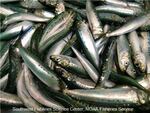
A sardine boom that peaked in 2007 has apparently gone bust. The population is so low this year, managers may not be able to open a fishery.
Courtesy of NOAA's Southwest Fisheries Science Center
The Pacific Fishery Management Council has yet to make the final call, but initial reports indicate there aren't enough fish to open a sardine fishery on the West Coast this year.
That's bad news for several fishing towns in Oregon and Washington, where the majority of the West Coast sardines were landed in the past several years, and where some processors focus primarily on sardines.
The latest population estimates show sardines have fallen below the 150,000 metric ton cutoff for opening a West Coast fishery.
Kerry Griffin, who manages sardines for the Pacific Fishery Management Council, said the numbers have been going down for several years. Now it's to the point where the council will likely close the sardine fishery altogether. He expects a lot of discussion at the council meeting this week about how many sardines other fisheries should be allowed to catch incidentally while targeting mackerel and squid. The exact reason for the population crash is a mystery, he said, but sardines are well-known for having natural boom and bust cycles.
Griffin said the sardine fishery used to be more concentrated in California when the population was small, but in recent decades it expanded and has had a big economic impact along the Oregon and Washington coasts.
"It's a significant thing off Oregon and Washington," he said. "Although sardine fishing doesn't generate the kind of money other fisheries do, it's a very important source of income for small communities up and down the West Coast. A couple million dollars processed out of Westport, Washington, or Astoria has a big impact."
Port of Astoria Commissioner Bill Hunsinger said numerous processors in Clatsop County handle sardines. Altogether, they've been known to process 8,000 tons of sardines a day during the peak of the summer season.
"You think of the man hours to process 8,000 tons," he said. "That put a lot of people to work here. It has a tremendous impact on Clatsop County."
About a hundred boats participate in the West Coast sardine fishery. Their fish can be worth up to $20 million a year, depending on the catch. Several processing plants in Oregon and Washington focus primarily on sardines.
Ben Enticknap of the environmental group Oceana said the council should have acted sooner by closing the sardine fishery before the population dropped so low.
"We've been warning for years that they've been overfishing and the sardine population is collapsing," he said. "It's a really dire situation that we're in right now. Marine wildlife are starving due to a lack of prey, the sardine population is collapsing and it's impacting the health of our ocean ecosystem and it's also going to impact people."
A new study released Monday found fishing can worsen the natural population crashes in forage fish species.
Enticknap said he thinks the Pacific Fishery Management Council allowed fishermen to catch too many sardines, and that means it could take longer for the population to recover than it otherwise would.
"The past three years there has been overfishing while the population has been in this collapse," he said.
Griffin said closing the fishery doesn't mean managers allowed too much fishing.
"We have a pretty conservative approach to harvest of sardines," he said. "The management of the fishery is happening the way it's supposed to. When there's a lot of fish around, we allow moderately more fishing and when the fish are headed in the wrong direction, we ratchet it down until we close it."
Sardine fisherman Ryan Kapp whose dad co-owned the Astoria Pacific Seafoods sardine processing plant in Astoria, said people in the industry saw the downward trend, and they were ready for it because the boom and bust cycle of sardines is well known.
"You knew full well going into it that it was a cyclical deal," he said. "Guess we'll just kick back and relax for another 30 years."
Kapp said boats that were catching squid before the sardine population took off can go back to catching squid. Others may switch to shrimp or whiting fisheries. His dad already sold his sardine processing plant to another company that wanted it for cold storage.
"So, you kind of go 'OK. Mother Nature's doing her thing. Time to shift gears,'" Kapp said. "I'll go back to Alaska, which is where I was back in 1998-99 when this whole thing started. I'll go back and fish salmon. It still sucks. It was a great fishery."
His biggest complaint is that some people are trying to blame the population crash on overfishing.
"It's not an overfishing thing–at least not on this go-round," he said. "It's been responsibly managed."
Mike Okoniewski works for Pacific Seafoods, which owns numerous processing plants on the West Coast. He also sits on a board that advises the Pacific Fishery Management Council on sardines. He said it's pretty clear that the sardine population has reached the end of another cycle. His business will be hurt by a sardine fishery closure, he said, but maybe not as much as other processors who focus more exclusively on sardines.
"It'll be punishing for some guys more than others," Okoniewski said. "Sardines will be missed, for sure. I think this chapter in sardines is probably over for the time being. I'm not sure if I'll be around when they come back."
